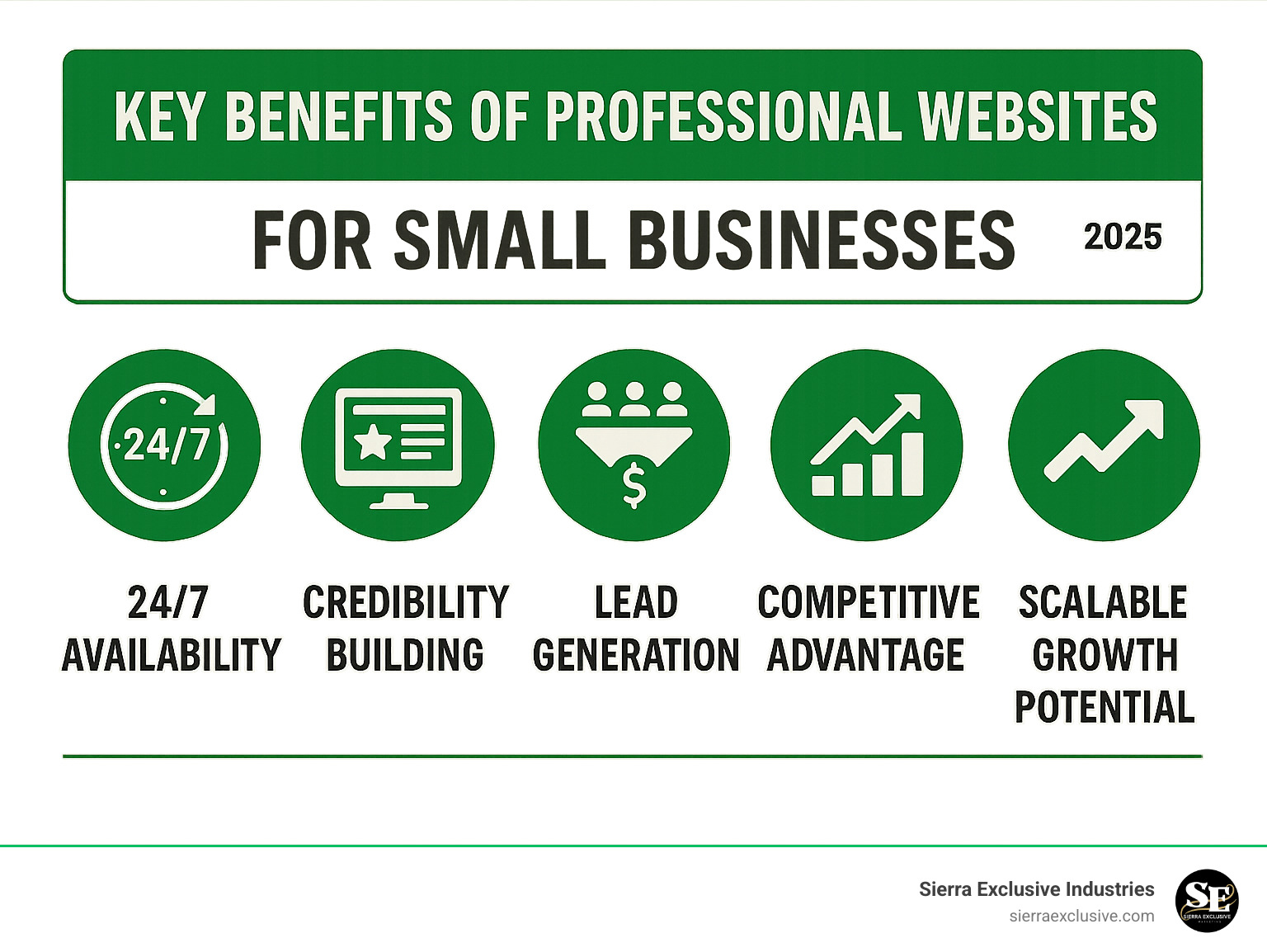Your Digital First Impression on a Dime
Affordable web design doesn’t mean settling for amateur results. In fact, finding the right balance between cost and quality can be the smartest investment a growth-stage business makes.
Quick Answer for Affordable Web Design:
- Cost Range: $500 – $2,500 for quality small business websites
- Timeline: 2-6 weeks for completion
- Key Features: Mobile-responsive, fast-loading, SEO-optimized, secure
- What’s Included: Custom design, hosting setup, basic SEO, contact forms
- Red Flags: $99 websites, no ownership rights, hidden fees, poor support
Remember when getting a professional website meant emptying your wallet? Those days are happily behind us. Today’s affordable web design options deliver impressive functionality without the premium price tag.
The challenge isn’t finding cheap web design – it’s finding value. As one industry expert puts it: “The difference between a good website and a bad one can make or break your brand.”
Your website is your 24/7 digital storefront. It’s working while you sleep, converting visitors into customers and building credibility with every click. For ambitious founders targeting $1M to $10M ARR, a professional online presence isn’t optional – it’s essential for sustainable growth.
The good news? You don’t need to spend 5 figures to get a website that performs. Smart businesses understand that affordable doesn’t mean amateur. It means finding the right partner who delivers quality work at a reasonable price.

Affordable web design terms you need:
Affordable Web Design
Affordable web design isn’t about finding the cheapest option—it’s about finding the smartest investment for your business. Think of it as the sweet spot where quality meets budget reality.
The truth is, not every business needs a $10,000 website. Often, a simple, fast, and professional site that gets the job done is all that’s required. That’s what we hear from our clients in Sacramento, Roseville, and beyond.
The goal of any website is to attract customers and help your business stand out. Yet many small businesses settle for mediocre sites, not realizing their impact on the bottom line or thinking professional help is out of reach.
Affordable web design bridges that gap. It’s about defining value over cheapness and understanding that balancing cost and quality is an art. You get a professional online presence, a 24/7 digital storefront, and the credibility to compete with larger companies.
For growing businesses, this approach is ideal. You’re not just getting a website; you’re establishing a digital foundation to reach new customers. It’s a smart choice for startups needing to prove their concept without emptying their bank account.
For more insights on how this works for small businesses specifically, check out our website design for small business services.
The Smart Business Case for a Budget-Friendly Website
Starting with a budget-friendly website is a brilliant strategy. A lower upfront investment frees up capital for marketing and operations. Plus, you get to market faster, and in business, speed often wins.
This approach lets you prove your business concept without betting the farm on your website. You can test the waters, see what works, and upgrade later as you grow. Meanwhile, your professional site levels the playing field, allowing you to compete with larger companies.
The complexity of even “starter sites” is often underestimated. There’s a vast difference between DIY builders and professional design. Our goal is to provide value that prevents future rebuilds and technical headaches, saving you money long-term.
Your website should attract customers from day one. We ensure it does exactly that, without the premium price tag that might delay your launch.
For Canadian entrepreneurs just starting out, the Government of Canada’s business resources offer excellent guidance on smart budget allocation for new ventures.
What’s Typically Included in a Low-Cost Package?
A quality, affordable web design package should give you everything for a strong online presence. While every provider is different, here’s what to expect from a reputable partner:
Custom design using professional templates gets you a unique look without starting from scratch. A mobile-responsive layout ensures your site looks great on all devices. Most packages include around five core pages: homepage, about, services, contact, and a gallery or testimonials page.
Contact form integration lets visitors reach you, while basic SEO setup helps search engines find your content. You’ll also get an image gallery, social media links, and secure hosting for an initial period.
Domain connection gets your web address working, and an SSL certificate keeps everything secure with “HTTPS.” Most providers also handle content upload and give you basic training on making simple updates.
The best part? You should get a set number of revisions during the design process to ensure you’re happy with the result.
The hallmark of a great affordable web design partner is transparency. We believe in “no bloated themes, no hidden fees, no nonsense.” You should always know exactly what you’re getting and what it costs.
The Non-Negotiable Features of a High-Quality, Low-Cost Website
When aiming for a high-quality, low-cost website, certain features are simply non-negotiable. These aren’t just bells and whistles; they are the core components that ensure your site is effective, user-friendly, and set up for long-term success. Think of them as the foundation upon which your digital presence is built, crucial for attracting and converting customers in Sacramento, Folsom, or anywhere else your audience might be.

A great affordable website should embody user-friendly navigation, fast load times, mobile-friendliness, attractive visual design, clear calls-to-action, informative content, and robust security through SSL. Every page of your website should be built with your strategic marketing plan in mind, because a web designer should also be a marketer at heart. For a deeper dive into what makes a website truly effective, consider this helpful primer on modern web design.
1. Mobile-First, Responsive Design
This is paramount. More people now view websites on mobile devices than desktops. Google’s mobile-first indexing means your site could lose rankings if it doesn’t perform well on mobile. A responsive design ensures your website automatically adjusts and looks great on any device, providing a seamless experience for all users. This not only improves user retention but also signals to search engines that your site is modern and user-friendly. We ensure your website works well on all devices, especially mobile phones, making it a standard inclusion, not an expensive add-on.
2. Blazing-Fast Load Speed
In today’s digital world, user attention spans are fleeting. If your site takes more than 3 seconds to load, you can lose up to 50% of your traffic. This isn’t just a minor inconvenience; it directly impacts your traffic and conversions. Faster websites are favored by Google for SEO rankings and are proven to result in more traffic and conversions. We prioritize optimizing core web vitals for faster load times, utilizing techniques like image optimization and lightweight code to ensure your site is blazing fast.
To find how our web design services can help you achieve optimal site performance and aesthetics, visit our More info on our Web Design services page.
3. Foundational SEO
Having a beautiful website is great, but what good is it if no one can find it? Foundational SEO (Search Engine Optimization) is about making your website findable on search engines like Google. This includes on-page optimization, which involves ensuring your site has editable title tags, meta descriptions, and a clean URL structure. We bake in basic SEO elements from the ground up, including local SEO basics, to help your business get found online. The homepage is often the most valuable page for ranking local keywords. SEO is not just a feature; it’s an ongoing process that involves on-page, off-page, and technical optimization.
4. Rock-Solid Security
In an era of increasing cyber threats, a secure website is non-negotiable. An SSL certificate (indicated by “HTTPS” in your browser’s address bar) is a must-have for encrypting data and building trust with your visitors. Beyond this, a quality affordable web design includes protection against hackers, regular backups, secure login practices, and measures for customer data protection. Proper coding standards are crucial to prevent security vulnerabilities and technical debt, safeguarding your business and your customers in locations like Elk Grove, Rancho Cordova, and beyond.
How to Spot a Great Affordable Web Design Partner
Finding the right affordable web design partner can feel overwhelming, but it doesn’t have to be. Think of it like hiring any other professional – you want someone who delivers quality work, communicates clearly, and respects your budget. The key is knowing what to look for and what red flags to avoid.
We’ve seen too many businesses get burned by providers who promise the world for pennies, only to deliver amateur results or disappear after taking payment. That’s why doing your homework upfront is so important. A little due diligence now can save you thousands later.
The good news? Quality affordable web design providers are out there. They’re the ones who understand that building long-term relationships matters more than quick profits. They’ll be transparent about their process, proud of their work, and honest about what they can deliver within your budget.
For more insights into choosing the right partner, check out our Website Design Company page.
Review Their Portfolio and Testimonials
A reputable provider will be excited to show off their work. Their portfolio should tell a story of diverse project examples that demonstrate real functionality, not just pretty pictures. Look for sites that actually work well – ones that load quickly, look professional, and feel easy to steer.
Pay special attention to industry relevance. If they’ve worked with businesses similar to yours, that’s a great sign. They’ll understand your audience and the features that matter most to your industry.
But here’s what really matters: live site examples. Don’t just look at screenshots – click through to the actual websites. Test them on your phone. See how they perform in real-world conditions. A site that looks great in a portfolio image but crawls on mobile isn’t worth your investment.
Third-party reviews on platforms like Google or Clutch offer genuine insights you can trust. Look for comments about communication, meeting deadlines, and post-launch support. Video testimonials are even better – they’re harder to fake and give you a real sense of client satisfaction.
Demand Transparent Pricing and Clear Contracts
This is where many businesses get into trouble. If a provider won’t give you clear, upfront pricing, that’s a massive red flag. Quality affordable web design companies have nothing to hide – they’ll break down exactly what’s included and what isn’t.
Ownership rights are crucial. You should own your website, your content, and your design elements. Period. If a provider wants to retain ownership or charge you extra to transfer your site later, run the other way.
Make sure you understand revision limits upfront. Most providers include a reasonable number of changes, but unlimited revisions can quickly eat into their margins (and your timeline). Post-launch support costs should also be clearly outlined – what’s included for free, and what requires additional payment.
Always get everything in writing. A detailed scope of work protects both you and your designer, ensuring everyone’s on the same page about deliverables and timelines.
The Typical Design Process Explained
Understanding the web design process helps you spot professionals from amateurs. A structured approach shows they’ve done this before and know how to deliver results efficiently.

The consultation phase is where everything starts. A good provider will ask thoughtful questions about your business goals, target audience, and brand identity. They’re not just taking an order – they’re learning how to create something that works for your specific needs.
During design and development, they’ll create mockups and build your site’s functionality. For affordable solutions, this often means customizing a proven template to fit your brand. There’s nothing wrong with this approach – it’s actually smart business that keeps costs down while ensuring quality.
The review and revision stage is your chance to provide feedback and request changes. Quality providers build this into their timeline and pricing, offering a set number of revisions to ensure your satisfaction.
Finally, launch and support means getting your site live and making sure everything works properly. They’ll handle domain connection, hosting setup, and provide initial training on managing your site.
This structured approach ensures clarity and efficiency, helping deliver high-quality, affordable websites in a timely manner. For a detailed look at our own methodical approach, explore Understanding the Digital Building Process.
The Hidden Dangers of “Rock-Bottom” Cheap Web Design
Affordable web design is smart business, but rock-bottom pricing? That’s a different story entirely. We’ve watched too many businesses in Antelope, Carmichael, and Woodland get burned by deals that seemed too good to be true – because they were.

There’s a world of difference between strategic, value-driven web design and the bottom-of-the-barrel options that flood the market. When someone offers you a “complete website” for less than you’d spend on a nice dinner, red flags should be waving.
The harsh reality is that these ultra-cheap solutions come loaded with hidden costs, technical debt, and long-term problems that can actually cost you more money – and damage your reputation – down the road. As one industry expert puts it: “The cheaper you want it, the cheaper you get it.”
The True Cost of a $99 Website
Let’s pull back the curtain on what you’re really getting when you choose the absolute cheapest option available. Spoiler alert: it’s rarely what you think you’re buying.
Poor security vulnerabilities are often the first nasty surprise. Poorly written code becomes a welcome mat for hackers, malware, and data breaches. Your business reputation and customer trust can be destroyed overnight – and rebuilding both is far more expensive than investing in proper security from the start.
No ongoing support means you’re flying solo the moment your site goes live. Need to fix a broken contact form? That’ll be extra. Want to update your business hours? Hope you know how to code. Any issues, updates, or changes will hit you with additional fees that quickly surpass what you’d pay for quality work upfront.
Here’s the kicker: you don’t actually own your site. Many ultra-cheap providers retain ownership of your code, design, or even your content. You’re essentially renting space in their digital ecosystem, unable to migrate or make independent changes. It’s like buying a car but never getting the keys.
Terrible SEO performance is practically guaranteed. These sites are built without search engine optimization in mind, featuring poor structure, slow loading times, and missing the essential elements that help Google understand and rank your content. You might as well be invisible online.
Slow performance will hemorrhage your traffic. Unoptimized images, bloated code, and bargain-basement hosting create painfully slow load times. 3-second rule? You’ll lose half your visitors before they even see your homepage.
The unprofessional appearance speaks volumes about your brand – and none of it good. Generic templates, outdated designs, and amateur execution give potential customers a negative first impression that’s hard to overcome.
How to Avoid the Pitfalls
Protecting yourself from these dangers requires shifting your focus from price alone to genuine value. Smart businesses ask the right questions upfront.
Ask about ownership rights to everything – your website, content, domain, and any custom work. You should have complete control over your digital assets.
Clarify support plans in detail. What’s included after launch? What costs extra? How quickly will they respond to issues? Get specific answers, not vague promises.
Check for performance features like mobile responsiveness, fast load times, and basic SEO setup. These aren’t luxury add-ons – they’re essential foundations.
Read the fine print carefully. Look for hidden fees, revision limits, or clauses that restrict your control. If they’re not transparent about terms, that’s a red flag.
Prioritize value over the lowest price tag. Investing smartly means choosing a partner who provides quality work that supports your business goals. Sometimes spending a bit more upfront saves you thousands later – and protects your brand reputation in the process.
Frequently Asked Questions about Affordable Web Design
When you’re considering affordable web design for your business, it’s natural to have questions. We’ve worked with countless businesses across West Sacramento, Lincoln, and our broader service area, and we hear the same concerns time and again. Let’s tackle the most common questions that keep business owners up at night.
How much should a quality affordable web design for a small business cost?
Here’s the honest truth: quality affordable web design for a small business typically ranges from a few hundred to a few thousand dollars. This isn’t a cop-out answer – it’s reality. The wide range exists because every business has different needs, and several factors influence the final investment.
The number of pages you need makes a significant difference. A simple five-page site costs less than a comprehensive fifteen-page website with custom features. Special functionalities like e-commerce capabilities, booking systems, or custom contact forms add to the complexity and cost.
Project structure also matters. Some providers offer one-time project costs where you pay upfront for everything. Others use subscription models that spread costs over time but include ongoing hosting and maintenance. Both approaches have merit – it’s about finding what works for your cash flow and business model.
The value of included services can dramatically affect your total investment. A package that includes secure hosting, SSL certificates, basic SEO setup, and initial maintenance might cost more upfront but saves money long-term compared to piecing these services together separately.
Our advice? Focus on value over the lowest price tag. A well-built website is an investment that pays dividends through increased credibility, lead generation, and customer conversions. The cheapest option often becomes the most expensive when you factor in rebuilds, security issues, and lost opportunities.
Can I update the website myself later?
Absolutely! One of the biggest advantages of modern affordable web design is that you don’t need to call a developer every time you want to change a phone number or add a new service description.
The key is having a proper Content Management System (CMS). Most quality affordable websites are built on platforms like WordPress, which provides an intuitive dashboard for making updates. Think of it like editing a document – you can add text, upload images, and organize content without touching a single line of code.
What you can typically handle yourself includes updating contact information, adding new blog posts, uploading photos to your gallery, and making basic text changes. These everyday updates are designed to be user-friendly so you maintain control over your content.
Training and documentation are crucial parts of the process. A good web design partner will provide clear instructions and might even offer a brief training session to show you the ropes. Don’t worry – it’s much easier than it sounds!
For more complex updates like adding new functionality, major design changes, or technical optimizations, you’ll likely want professional help. Many providers offer ongoing maintenance plans that handle security updates, performance monitoring, and technical troubleshooting. This hybrid approach gives you day-to-day control while ensuring your site stays secure and performs well.
How long does it take to build an affordable website?
The timeline for affordable web design typically falls between 2 to 6 weeks, but several factors can influence this schedule. Understanding these factors helps set realistic expectations and ensures a smoother process.
Simple, straightforward websites with basic pages and standard features can often be completed in 1 to 2 weeks. These might include a homepage, about page, services page, and contact form – perfect for service businesses that need an online presence quickly.
More complex projects requiring custom features, extensive content, or specialized functionality might take 6 to 8 weeks. This includes sites with e-commerce capabilities, booking systems, or custom integrations.
Client responsiveness is the biggest factor affecting timeline. When you provide feedback quickly and approve designs promptly, the project moves faster. Delays in decision-making can extend the timeline significantly.
Content delivery is another critical factor. Having your text, images, and other materials ready before the project starts – or delivering them early in the process – prevents bottlenecks. Many project delays stem from waiting for content rather than technical issues.
Scope complexity naturally affects timing. The more custom features, pages, and specialized elements your site requires, the longer it takes to build properly. However, this extra time investment usually results in a more effective website that better serves your business goals.
Communication and collaboration play huge roles in keeping projects on track. Clear expectations, regular check-ins, and prompt feedback create an environment where quality work can be delivered efficiently.
The bottom line? Most businesses can expect their new website to be live and ready to attract customers within a month to six weeks, assuming good communication and timely content delivery.
Conclusion: Investing Smartly for Sustainable Growth
Affordable web design represents one of the smartest investments you can make for your growing business. Throughout this guide, we’ve explored how the right approach to web design balances cost with quality, delivering professional results that support your long-term success.
Your website isn’t just another business expense – it’s a valuable digital asset that works around the clock to build credibility, attract customers, and drive growth. Whether you’re serving clients in Sacramento, expanding to new markets, or scaling from startup to your first million in ARR, a professionally designed website forms the foundation of your digital presence.
The key takeaway? Focus on long-term value rather than the lowest upfront cost. We’ve seen how mobile-first design, blazing-fast load speeds, foundational SEO, and rock-solid security aren’t just nice-to-have features – they’re essential elements that determine whether your website becomes a growth engine or a missed opportunity.
Remember the hidden dangers of rock-bottom pricing. A $99 website might seem tempting, but the true cost often includes poor security, no ongoing support, terrible SEO performance, and ultimately, damage to your brand reputation. Smart business owners understand that investing in quality affordable web design prevents these costly pitfalls.
At Sierra Exclusive Business Consulting and Marketing Agency, we’ve built our reputation on helping emerging businesses achieve sustainable growth. We understand the journey from startup to $1 million ARR and beyond, and we know that growth-focused strategies start with a solid digital foundation.
Your website should evolve with your business, supporting your expansion from local markets to regional leadership. By choosing a transparent partner who provides clear contracts, ongoing support, and genuine expertise, you’re not just buying a website – you’re investing in a platform for sustainable growth.
Ready to build that strong foundation for your online success? Take the next step with our expert web design services and find how the right digital strategy can accelerate your path to market leadership.




